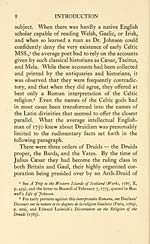Download files
Complete book:
Individual page:
Thumbnail gallery: Grid view | List view

INTRODUCTION 9
great influence. They worshipped certain gods and
goddesses, taught the doctrine of metempsychosis
or rebirth, and held both oak and mistletoe sacred.
It is thought that they practised human sacrifice,
and that they made use in their ceremonies of huge
stone monuments which are still to be seen through-
out Britain. In the Middle Ages there were numer-
ous Welsh Bards (said to have been exterminated
by Edward I), who may conceivably have been the
descendants of the ancient Bards of pre-Christian
days.
Knowing as we do to-day that Druidism was at
its height several centuries before the Christian era,
we cannot but wonder that the eighteenth-century
critics were forever confusing the Druidism of the
Celts with the Valhalla belief of the Scandinavians
— a religion which dates from the days of the Vi-
kings! But that they did confuse the two is undeni-
able. Professor Farley, who has made a detailed
study of the matter, has already pointed out that
Mallet, following Cluverius and Pelloutier, made
the blunder in his Histoire de Danemarc but was cor-
rected by Bishop Percy; that Mason did the same
thing in Caractacus; that Gibbon called the Edda
**the sacred book of the ancient Celts"; that for
this same blunder the Critical Review attacked J. P.
Andrews's History of the Great Britain, Joseph Ster-
ling's ode Scalder, Charles Pougin's Essai sur les
Antiquitts du Nord, and an anonymous poem called
great influence. They worshipped certain gods and
goddesses, taught the doctrine of metempsychosis
or rebirth, and held both oak and mistletoe sacred.
It is thought that they practised human sacrifice,
and that they made use in their ceremonies of huge
stone monuments which are still to be seen through-
out Britain. In the Middle Ages there were numer-
ous Welsh Bards (said to have been exterminated
by Edward I), who may conceivably have been the
descendants of the ancient Bards of pre-Christian
days.
Knowing as we do to-day that Druidism was at
its height several centuries before the Christian era,
we cannot but wonder that the eighteenth-century
critics were forever confusing the Druidism of the
Celts with the Valhalla belief of the Scandinavians
— a religion which dates from the days of the Vi-
kings! But that they did confuse the two is undeni-
able. Professor Farley, who has made a detailed
study of the matter, has already pointed out that
Mallet, following Cluverius and Pelloutier, made
the blunder in his Histoire de Danemarc but was cor-
rected by Bishop Percy; that Mason did the same
thing in Caractacus; that Gibbon called the Edda
**the sacred book of the ancient Celts"; that for
this same blunder the Critical Review attacked J. P.
Andrews's History of the Great Britain, Joseph Ster-
ling's ode Scalder, Charles Pougin's Essai sur les
Antiquitts du Nord, and an anonymous poem called
Set display mode to: Large image | Transcription
Images and transcriptions on this page, including medium image downloads, may be used under the Creative Commons Attribution 4.0 International Licence unless otherwise stated. ![]()
| Early Gaelic Book Collections > Ossian Collection > Celtic revival in English literature > (27) |
|---|
| Permanent URL | https://digital.nls.uk/78489090 |
|---|
| Description | Selected books from the Ossian Collection of 327 volumes, originally assembled by J. Norman Methven of Perth. Different editions and translations of James MacPherson's epic poem 'Ossian', some with a map of the 'Kingdom of Connor'. Also secondary material relating to Ossianic poetry and the Ossian controversy. |
|---|
| Description | Selected items from five 'Special and Named Printed Collections'. Includes books in Gaelic and other Celtic languages, works about the Gaels, their languages, literature, culture and history. |
|---|

